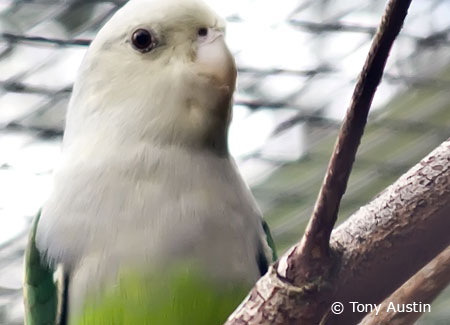Madagascar Lovebirds
Common Names: Madagascar Lovebird and
Grey-headed Lovebird
Scientific Name: Agapornis cana
Origin: Madagascar
Relative Size: Small 30-40 grams
Average Lifespan: Unknown

General Information about Madagascar Lovebirds
Madagascar Lovebirds are the only lovebirds that do not come from Africa. They come from Madagascar, a large island in the Indian Ocean. These birds thrive well in cultivated land or cleared grasslands. It’s not uncommon to see them in the suburbs or near forest edges.
Madagascar Lovebird Habitat
In their natural habitat these birds enjoy fruits, but most dine on small seeds from grasses. They intermingle with flock members that can consist of 10 or more birds. These flocks allow them to scan for danger while foraging on the ground. Madagascar Lovebirds are very jumpy and timid birds. They cannot cope with stress and need their privacy in order to function in captivity. This lovebird is said to act more like a finch rather then a parrot.
Appearance
Madagascar Lovebirds are small. In fact, they are the smallest of all lovebird species. These birds are sexually dimorphic, which means they can be sexed visually. The male’s neck, head, and chest area are covered with gray. The female lacks the gray bib; however, her coloring is identical to the male. Both have yellowish markings under their tails, wings, and on the undersides; black markings highlight the wings and tail feathers.
Madagascar Lovebird Breeding
Breeding these birds is proving to be difficult. They do not thrive as well in captivity as other lovebirds. When breeding this specie, most require large aviaries with extreme privacy. Just checking on the Madagascar’s nest can cause them to abandon their eggs. Breeding Madagascar’s can be tricky. Since there is such a limited supply, many breeders are joining together to help stabilize their population inside the United States. Importing Madagascar Lovebirds is not an option since importing exotic birds ceased in 1993.
Madagascar Lovebird As Pets
It’s highly unlikely that the average bird enthusiast will ever come across a pet Madagascar Lovebird for a pet. If they do, it is believed these birds make lousy pets. They are very nervous and hate to be handled—even if handfed. It is safe to say that not enough time has been invested to really validate this statement. If breeding Madagascar Lovebirds continues to be successful, then one day more effort might be made into researching their pet potential.




